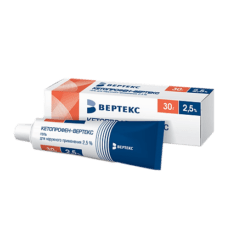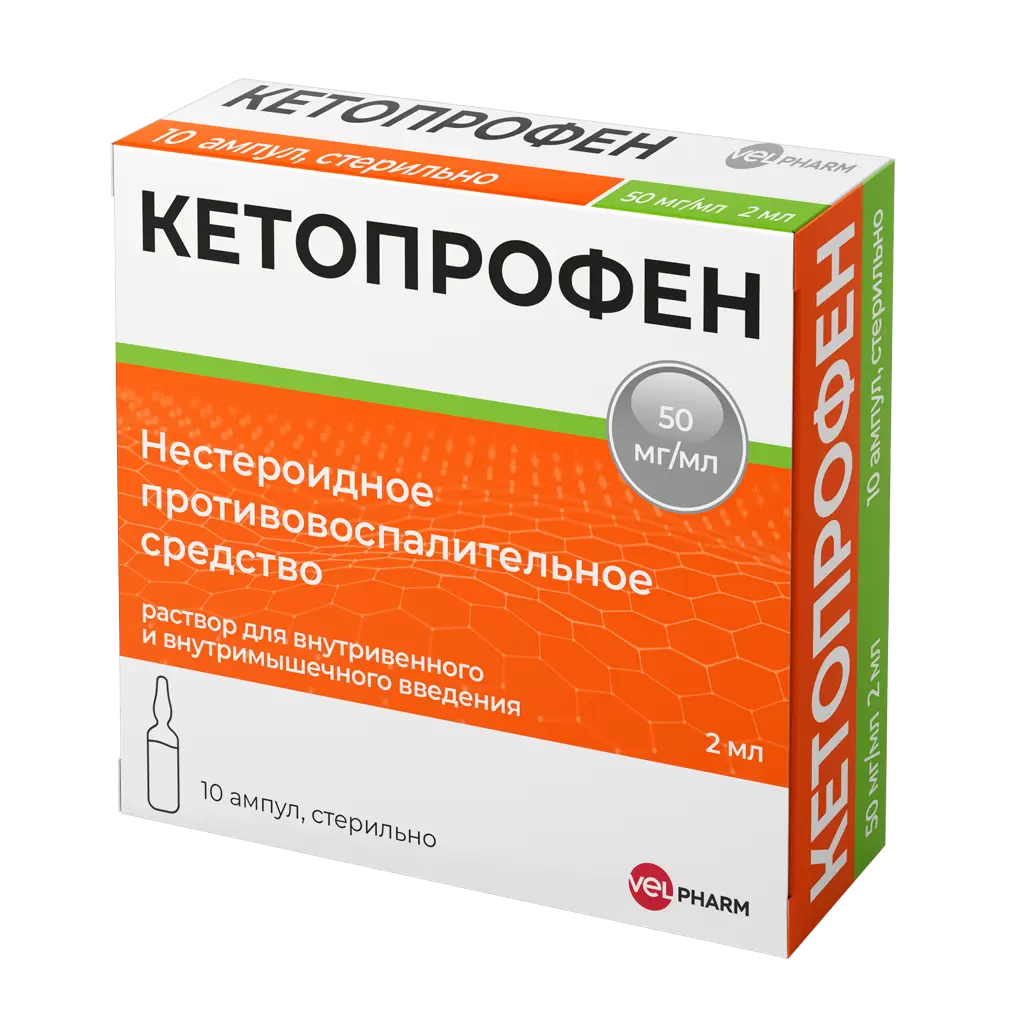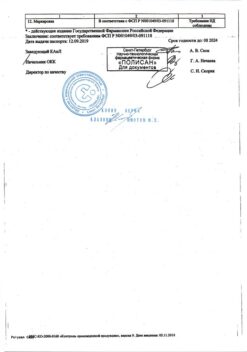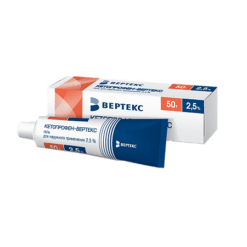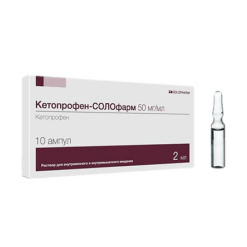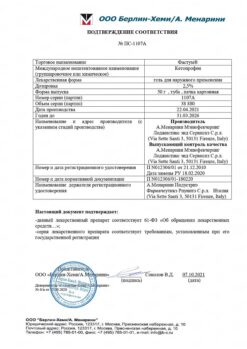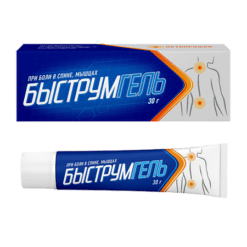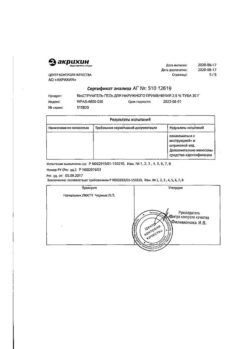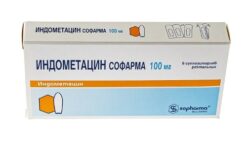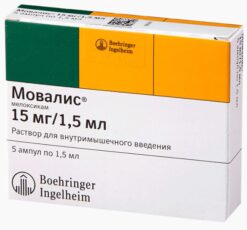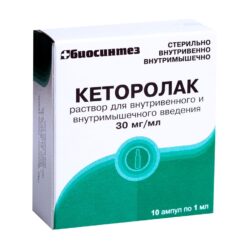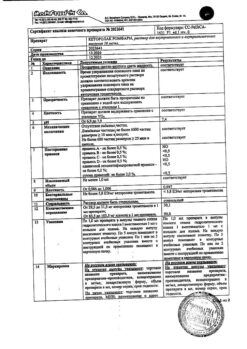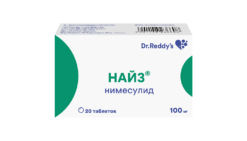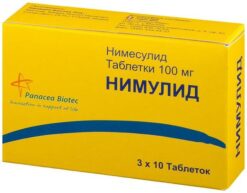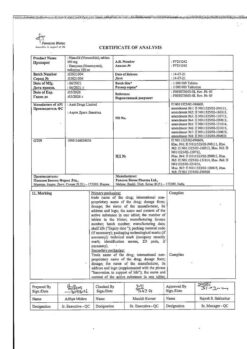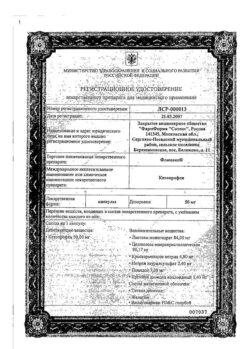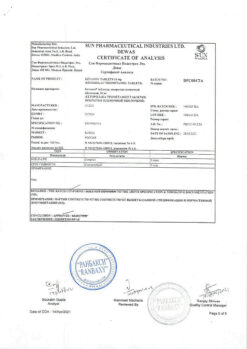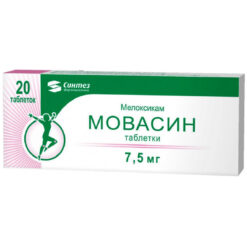Subtotal: €4.68
Ketoprofen, 50 mg/ml 2 ml 10 pcs
€2.47 €2.06
Out of stock
(E-mail when Stock is available)
Pharmacotherapeutic group: NSAIDs
Pharmacological action
NSAID, has anti-inflammatory, analgesic and antipyretic effect associated with inhibition of cyclooxygenase-1 (COX-1) and cyclooxygenase-2 (COX-2) activity, regulating the synthesis of prostaglandins (Pg).
Pharmacokinetics
Absorption and distribution
Bioavailability – more than 90%. Binding to plasma proteins – 99%. Time of reaching Cmax while parenteral administration – 15-30 min. Therapeutic concentration in synovial fluid is maintained for 6-8 hours. It does not penetrate through the BBB in a significant amount.
Metabolism and excretion
Almost completely metabolized in the liver by glucuronidation, subjected to the effect of “first passage” through the liver.
It is excreted mainly by the kidneys. It does not cumulate.
Indications
Inflammatory and degenerative diseases of the musculoskeletal system (rheumatoid, psoriatic arthritis, ankylosing spondylitis, gouty arthritis, osteoarthritis);
pain syndrome (myalgia, ossalgia, neuralgia, tendinitis, arthralgia, bursitis, radiculitis, adnexitis, otitis media, headache and toothache, cancer pain, post-traumatic and postoperative pain syndrome accompanied by inflammation);
algodismenorrhea.
The drug is intended for symptomatic therapy, reducing pain and inflammation at the time of use, and does not affect the progression of the disease.
Pharmacological effect
Pharmacotherapeutic group: non-steroidal anti-inflammatory drug (NSAID)
ATX code: [М01АЭ03]
Pharmacological properties
Pharmacodynamics
Ketoprofen is a non-steroidal anti-inflammatory drug (NSAID), has anti-inflammatory, analgesic and antipyretic effects associated with suppression of the activity of cyclooxygenase-1 (COX-1) and cyclooxygenase-2 (COX-2), which regulate the synthesis of prostaglandins (Pg).
Pharmacokinetics
Suction
With intravenous administration of ketoprofen, the average plasma concentration 5 minutes from the start of the infusion and up to 4 minutes after its cessation is 26.4 ± 5.4 mcg/ml. Bioavailability is 90%. With a single intramuscular injection of 100 mg of ketoprofen, the drug is detected in the blood plasma 15 minutes after injection, and the peak concentration (1.3 μg/ml) is reached after 2 hours.
The bioavailability of the drug increases linearly with increasing dose.
Distribution
Ketoprofen is 99% bound to plasma proteins, mainly to the albumin fraction. The volume of distribution in tissues is 0.1-0.2 l/kg. Ketoprofen penetrates into the synovial fluid, and with intravenous administration of 100 mg after 3 hours its concentration reaches 1.5 μg/ml, which is 50% of the concentration in blood plasma (about 3 μg/ml). After 9 hours, the concentration in the synovial fluid is 0.8 μg/ml, and in the blood plasma – 0.3 μg/ml, which means that ketoprofen penetrates the synovial fluid more slowly and is removed from it more slowly.
Steady-state plasma concentrations of ketoprofen are determined even 24 hours after its administration. After a single intramuscular injection of 100 mg of ketoprofen, the drug is detected in the cerebrospinal fluid, as well as in the blood serum, after 15 minutes.
Metabolism
Ketoprofen undergoes intensive metabolism with the participation of microsomal liver enzymes. It binds to glucuronic acid and is excreted from the body as a glucuronide. There are no active metabolites of ketoprofen.
Removal
The half-life (T1/2) of ketoprofen is 2 hours. Up to 80% of ketoprofen is excreted by the kidneys within 24 hours, mainly (more than 90%) in the form of ketoprofen glucuronide, and about 10% through the intestines.
In patients with renal failure, ketoprofen is excreted more slowly, its T1/2 increases by 1 hour.
In patients with liver failure, T1/2 increases, so accumulation in tissues is possible.
In elderly patients, the metabolism and elimination of ketoprofen is slower, which is of clinical significance only for patients with severe renal impairment.
Special instructions
During treatment, it is necessary to monitor the peripheral blood picture and the functional state of the liver and kidneys.
If it is necessary to determine 17-ketosteroids, the drug should be discontinued 48 hours before the study.
Taking ketoprofen can mask the signs of an infectious disease.
If renal or liver function is impaired, dose reduction and careful monitoring are necessary.
To reduce the risk of developing adverse events from the gastrointestinal tract, the minimum effective dose should be used in the shortest possible short course.
Impact on the ability to drive vehicles and operate machinery
During treatment, care must be taken when managing
vehicles and other potentially dangerous activities
activities that require increased concentration and speed
psychomotor reactions.
Active ingredient
Ketoprofen
Composition
1 ml of the drug contains:
Active ingredient: ketoprofen – 50.0 mg.
Excipients: propylene glycol, ethanol (ethyl alcohol), benzyl alcohol, 1 M sodium hydroxide solution, water for injection.
Pregnancy
The use of the drug in the third trimester of pregnancy is contraindicated.
The use of ketoprofen in the first and second trimesters of pregnancy is possible only if the potential benefit to the mother outweighs the risk to the fetus.
If it is necessary to use ketoprofen during lactation, the issue of stopping breastfeeding should be decided.
Contraindications
Complete or incomplete combination of bronchial asthma, recurrent hay fever of the nose and paranasal sinuses and intolerance to acetylsalicylic acid or other NSAIDs (including a history);
peptic ulcer of the stomach and duodenum in the acute phase;
ulcerative colitis (exacerbation);
diverticulitis;
peptic ulcer;
hemophilia and other blood clotting disorders;
active gastrointestinal bleeding;
severe renal failure (creatinine clearance less than 30 ml/min);
progressive kidney disease;
severe liver failure or active liver disease;
condition after coronary artery bypass surgery;
confirmed hyperkalemia;
inflammatory bowel diseases;
children’s age (up to 18 years);
pregnancy (III trimester);
lactation period;
hypersensitivity to the components of the drug and other NSAIDs.
With caution: anemia, bronchial asthma, alcoholism, tobacco smoking, alcoholic cirrhosis of the liver, hyperbilirubinemia, liver failure, dehydration, sepsis, chronic heart failure, edema, arterial hypertension, blood diseases (including leukopenia), stomatitis, ischemic heart disease, cerebrovascular diseases, dyslipidemia/hyperlipidemia, diabetes mellitus, peripheral arterial disease, chronic renal failure (creatinine clearance 30-60 ml/min), history of gastrointestinal ulcers, Helicobacter pylori infection, long-term use of NSAIDs, severe somatic diseases, concomitant use of oral corticosteroids (including prednisolone), anticoagulants (including warfarin), antiplatelet agents (including clopidogrel), selective serotonin reuptake inhibitors (including citalopram, fluoxetine, paroxetine, sertraline), old age, pregnancy (I and II trimester).
Side Effects
From the digestive system: NSAID gastropathy, abdominal pain, dyspepsia (nausea, vomiting, heartburn, flatulence, loss of appetite, diarrhea), stomatitis, liver dysfunction, ulceration of the gastrointestinal mucosa, gingival, gastrointestinal, hemorrhoidal bleeding; change in taste.
From the nervous system: headache, dizziness, insomnia, agitation, nervousness, drowsiness, depression, asthenia, confusion or loss of consciousness, forgetfulness, migraine, peripheral neuropathy.
From the senses: noise or ringing in the ears, blurred vision, conjunctivitis, dry mucous membrane of the eye, pain in the eyes, conjunctival hyperemia, hearing loss, vertigo.
From the cardiovascular system: increased blood pressure, tachycardia.
From the hematopoietic organs: agranulocytosis, anemia, hemolytic anemia, thrombocytopenia, leukopenia.
From the urinary system: edema syndrome, cystitis, urethritis, renal dysfunction, interstitial nephritis, nephrotic syndrome, hematuria.
Allergic reactions: skin rash (including erythematous, urticaria), skin itching, rhinitis, angioedema, bronchospasm, exfoliative dermatitis, anaphylactic shock.
Other: increased sweating, hemoptysis, nosebleeds, myalgia, muscle twitching, shortness of breath, thirst, photosensitivity, with long-term use in large doses – vaginal bleeding.
Interaction
Pharmaceutically incompatible with tramadol solution.
Reduces the effectiveness of uricosuric drugs.
Enhances the effect of anticoagulants, antiplatelet agents, fibrinolytics, ethanol, side effects of corticosteroids and mineralocorticosteroids, estrogens.
Reduces the effectiveness of antihypertensive drugs and diuretics.
Combined use with other NSAIDs, corticosteroids, ethanol, corticotropin can lead to the formation of ulcers and the development of gastrointestinal bleeding, increasing the risk of developing renal dysfunction.
Co-administration with oral anticoagulants, heparin, thrombolytics, antiplatelet agents, cefoperazone, cefamandole and cefotetan increases the risk of bleeding.
Increases the hypoglycemic effect of insulin and oral hypoglycemic drugs (dose recalculation is necessary).
Increases plasma concentrations of verapamil and nifedipine, lithium drugs, methotrexate.
Myelotoxic drugs increase the manifestations of hematotoxicity of the drug.
Overdose
Symptoms: nausea, vomiting, abdominal pain, vomiting blood, melena, impaired consciousness, respiratory depression, convulsions, impaired renal function, renal failure.
In case of overdose, symptomatic therapy, monitoring of respiratory and cardiovascular activity should be carried out; the use of histamine H2 receptor blockers and prostaglandin inhibitors is indicated. There is no specific antidote. Hemodialysis is ineffective.
Storage conditions
The drug should be stored out of the reach of children at a temperature not exceeding 25°C.
Shelf life
2 years.
Manufacturer
Velfarm LLC, Russia
| Shelf life | 2 years. |
|---|---|
| Conditions of storage | The drug should be kept out of reach of children at a temperature not exceeding 25 ° C. |
| Manufacturer | Welfarm, Russia |
| Medication form | solution |
| Brand | Welfarm |
Other forms…
Related products
Buy Ketoprofen, 50 mg/ml 2 ml 10 pcs with delivery to USA, UK, Europe and over 120 other countries.

